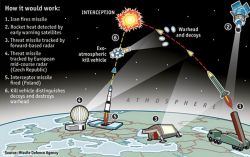Ballistic Missile Interception Test Facility Coming Up In Andhra State

A test facility to launch ballistic missile interceptors is being set up on a river island of the Krishna creek in Andhra Pradesh by the Indian Defence research and development organization (DRDO).
This is part of the DRDO's ballistic missile defence(BMD) project to shoot incoming enemy missiles out of the sky. According to a DRDO source, they had been facing problems in terms of range for the target missile that needs to be intercepted at the lower end of the parabolic arc as it enters the atmosphere.
The range DRDO needed is of 1500-2000 kms so that the target missile could have the full flight range and the interceptor can be tested to its full capacity.
There are two varieties of missile interceptors that the DRDO has been developing. The first is for an endo-atmospheric interceptor called the AAD, which intercepts a long range after it enters the earth's atmosphere at the terminal stage of the flight phase. The other is the exo-atmospheric PAD system that seeks to kill the target missile at the farthest distance possible from its target.
The DRDO has undertaken 7 tests, all of them inconclusive in proving them efficacy of the home grown BMD system. Ballistic missile interception is test-intensive and the DRDO has had to develop all the technology virtually from scratch. The new test range should help improve the accuracy of the DRDO's anti-missile system.
The proposed test range in an environmentally sensitive region and lies within the reserve forest area of the state. The DRDO, which has instituted an environmental impact assessment by a private agency, says that the source, is extremely conscious an organization for not disturbing the environmental ecology the area. They give the example of Wheeler Island where they have maintained the forested land and have, in fact, added to the vegetation.
The test range will act as a shield against nuclear-tipped ballistic missiles attacking India. The BMD will have a guidance radar network that can detect nuclear ballistic missiles which come in the flight range and also can track its flight path. It will also have a command and control system that can predict the enemy missile’s flight path and can assign interceptor missiles to destroy it.
With growing missile capability in the South Asian Region, the Indian armed forces are focusing on missile defence in recent times. Two long range tracking radars built by DRDO and ELTA were moved to Delhi last year for integration into the Indian Air Force (IAF) surveillance network. The radars have a range of 800-1000 kms.









